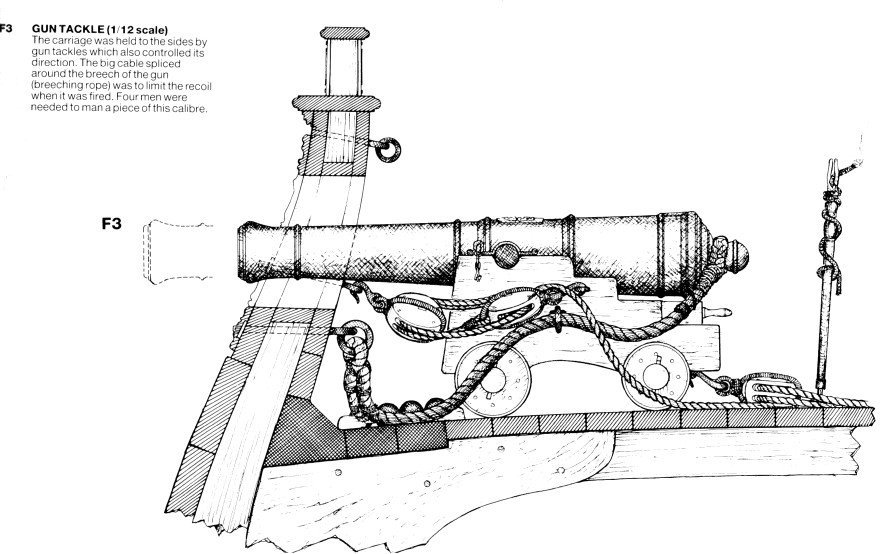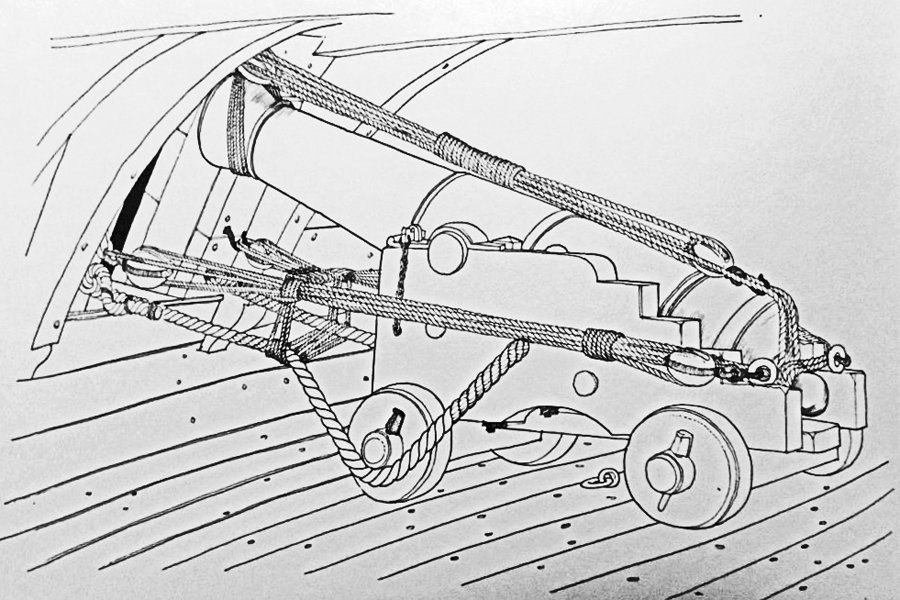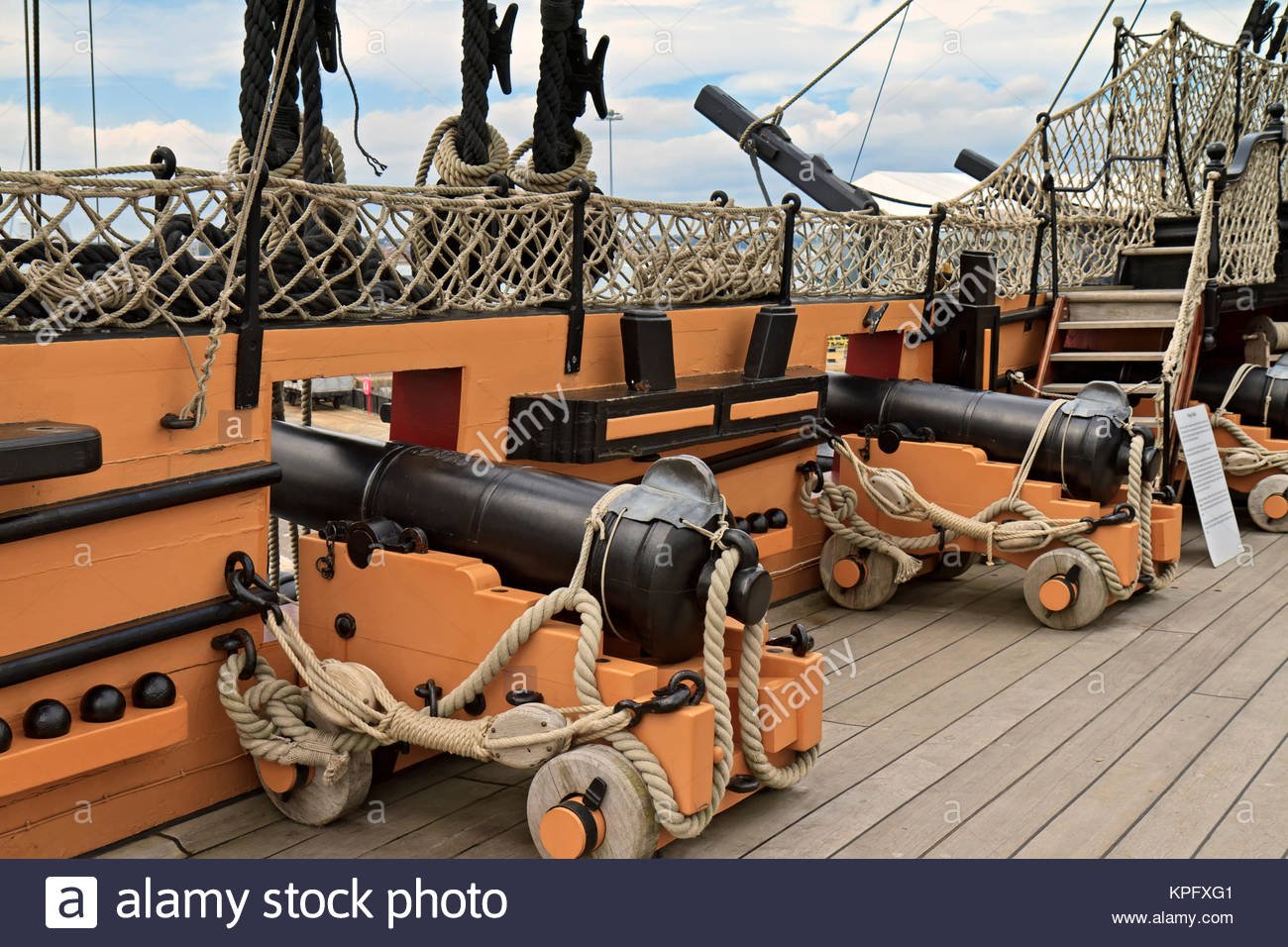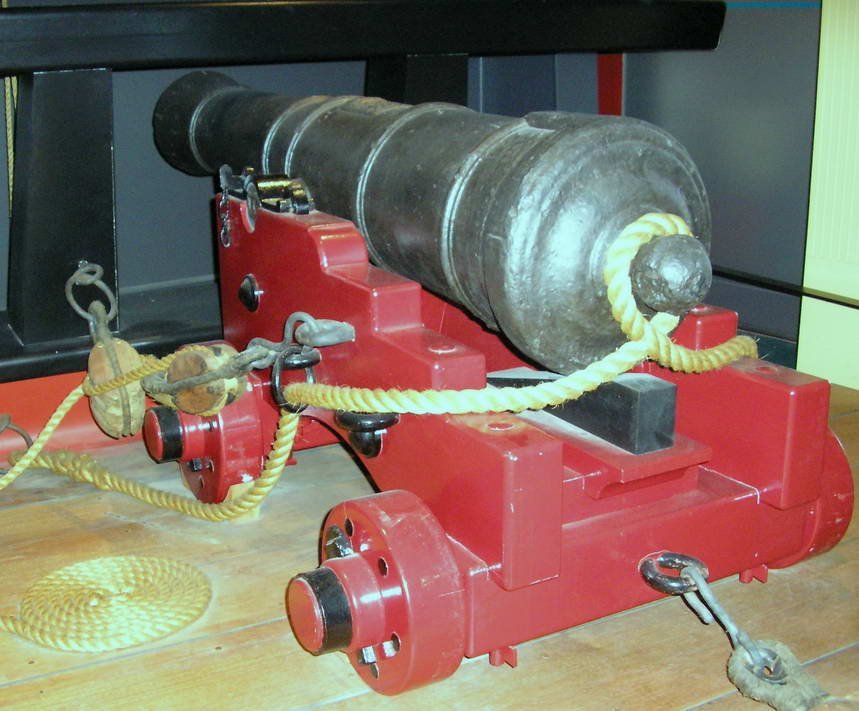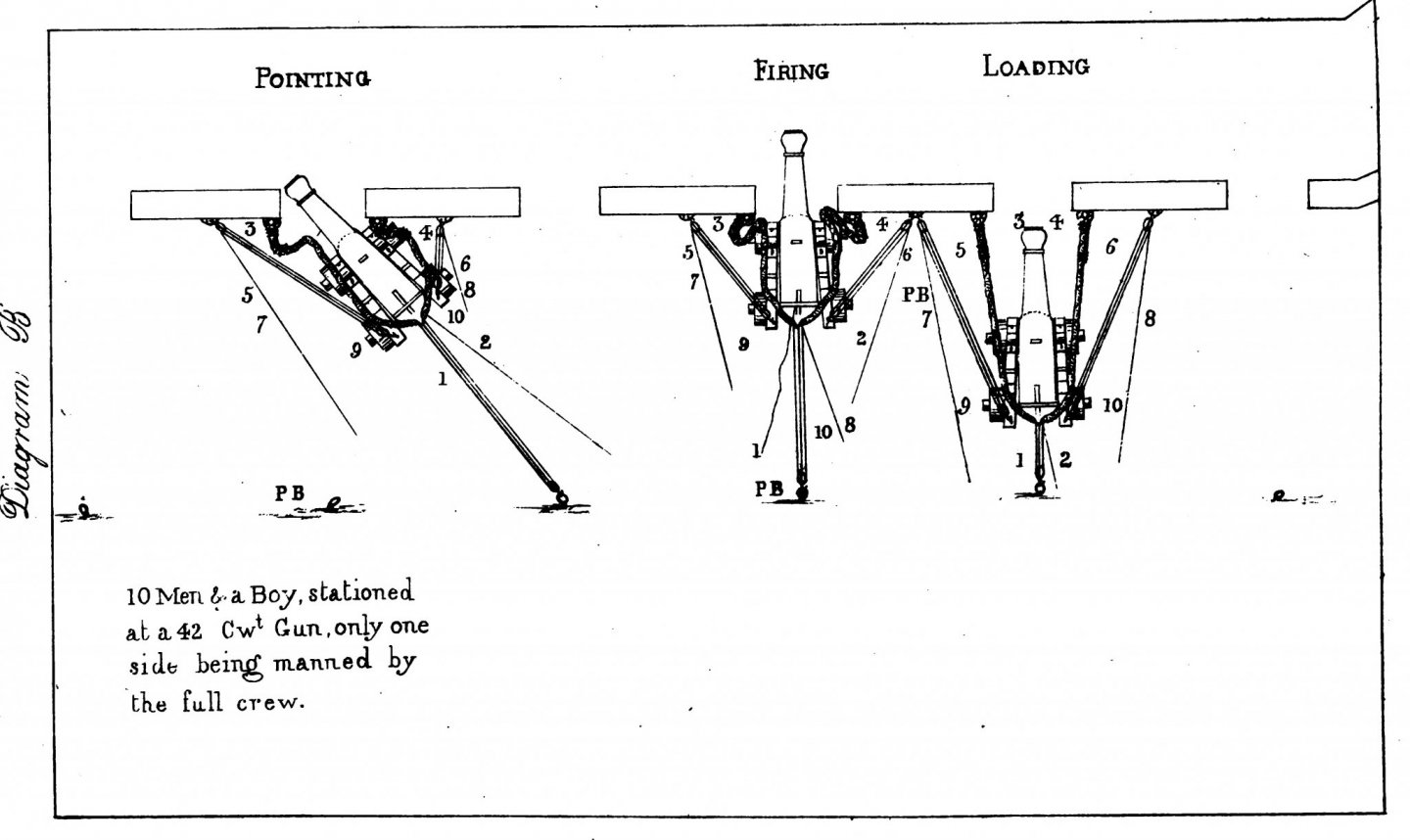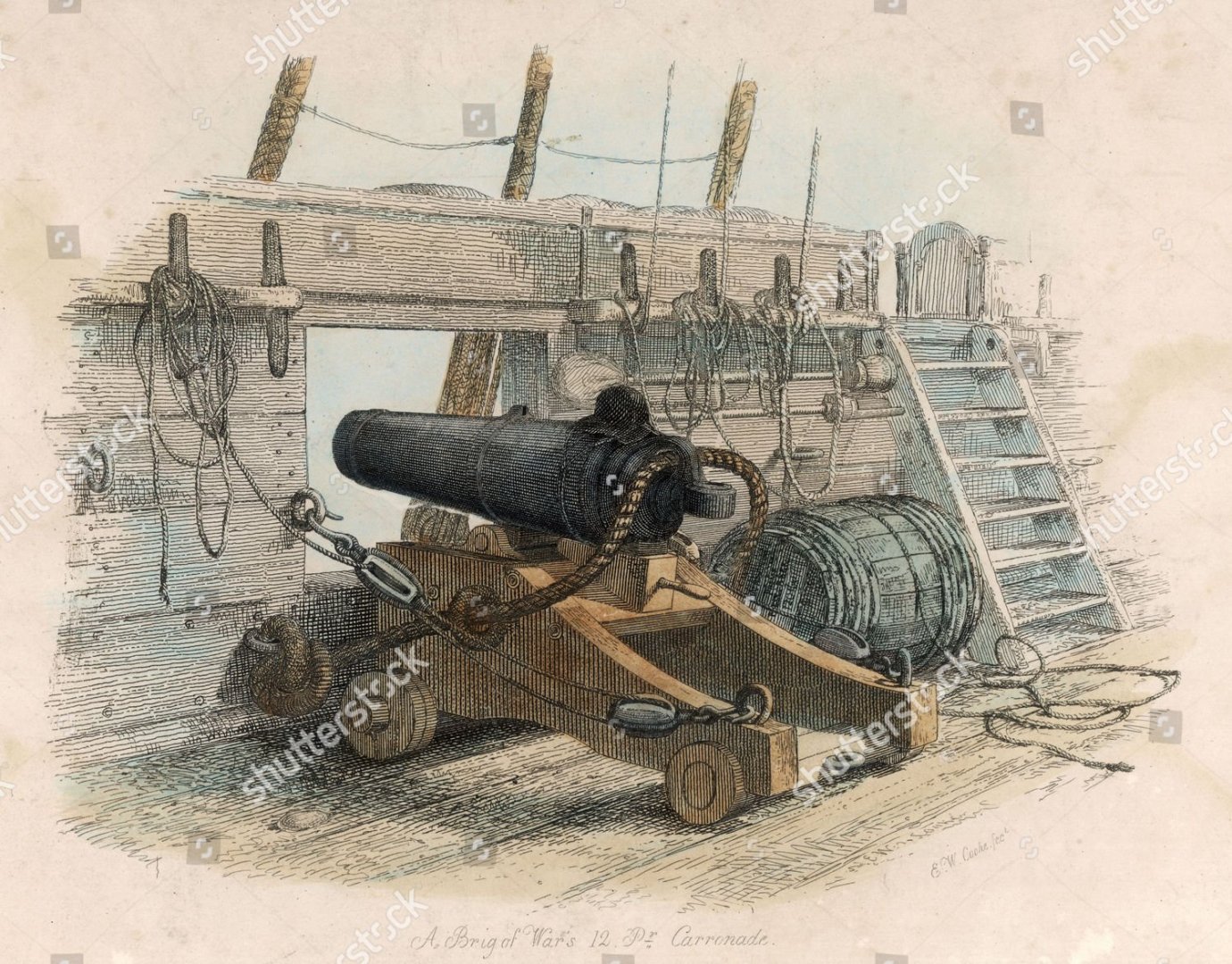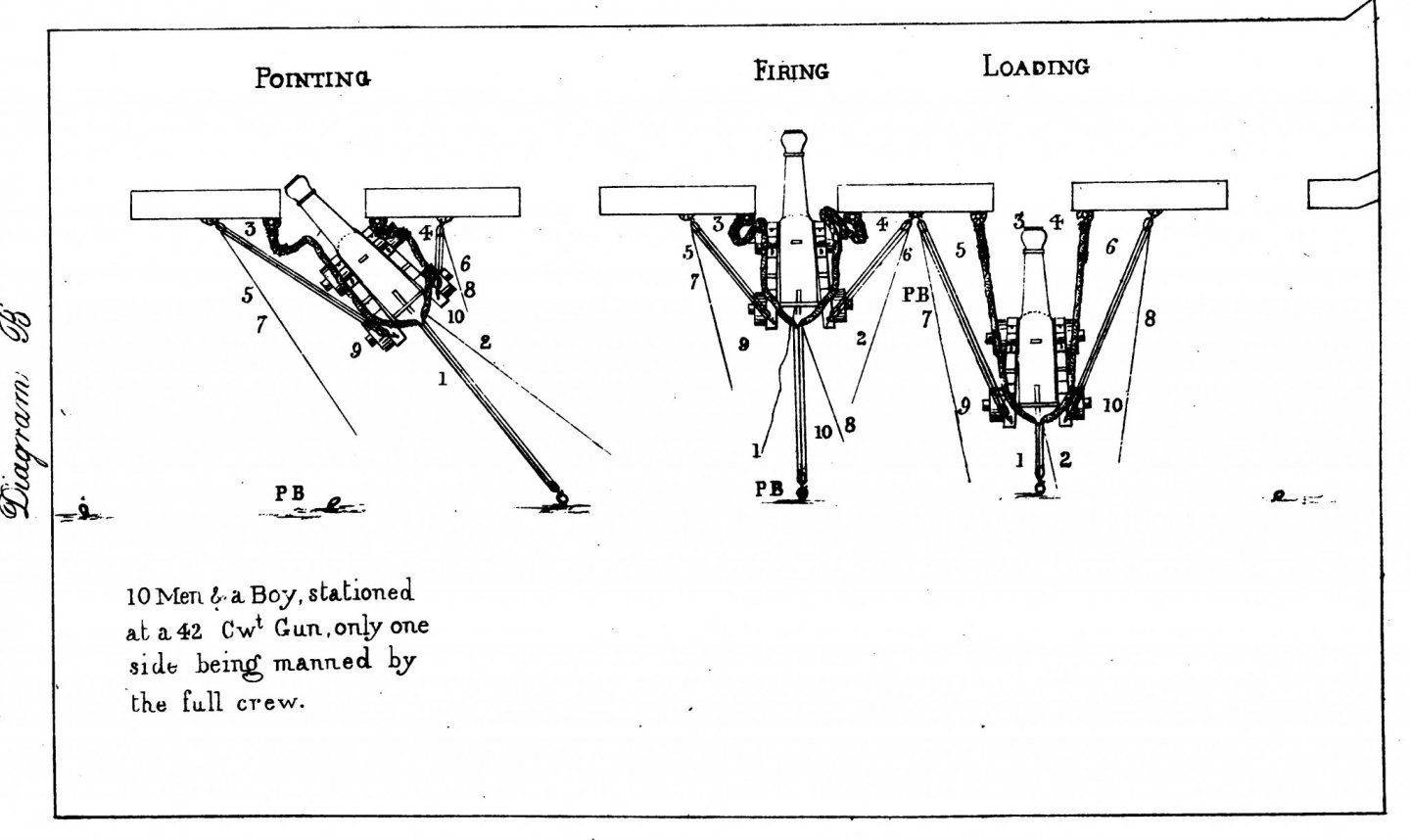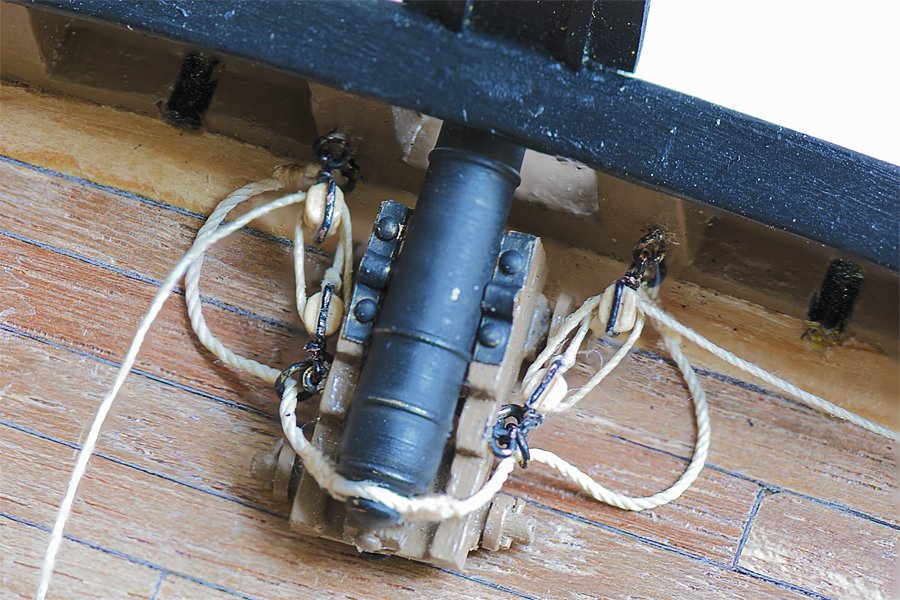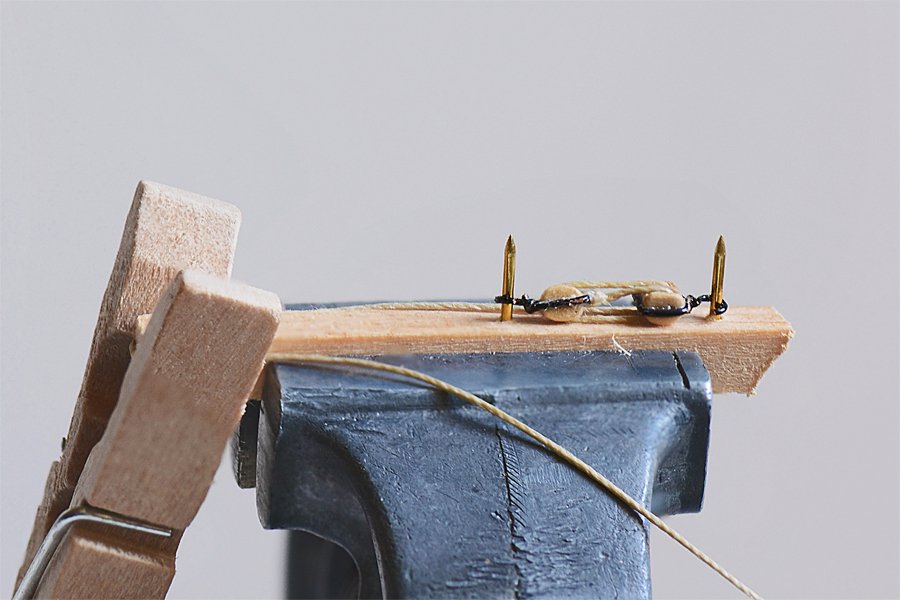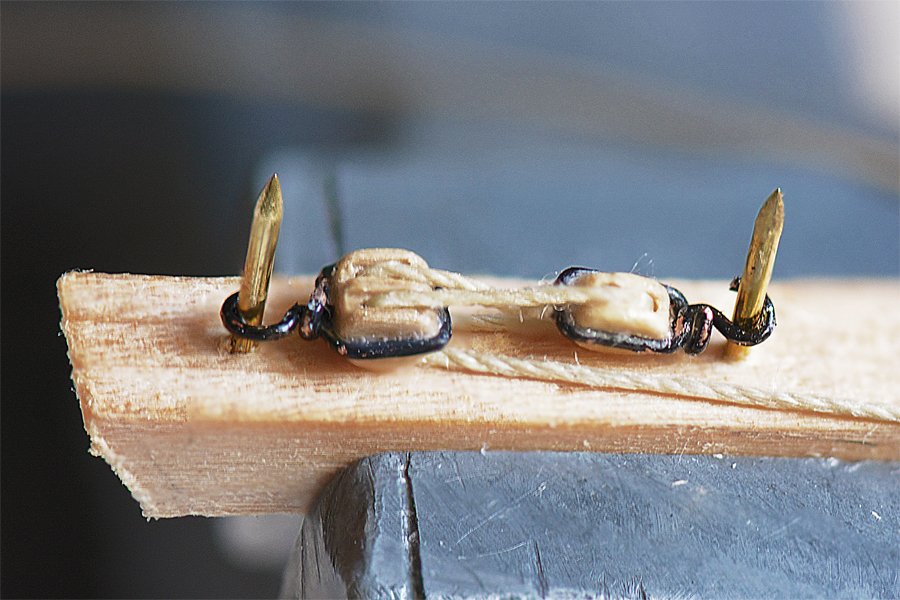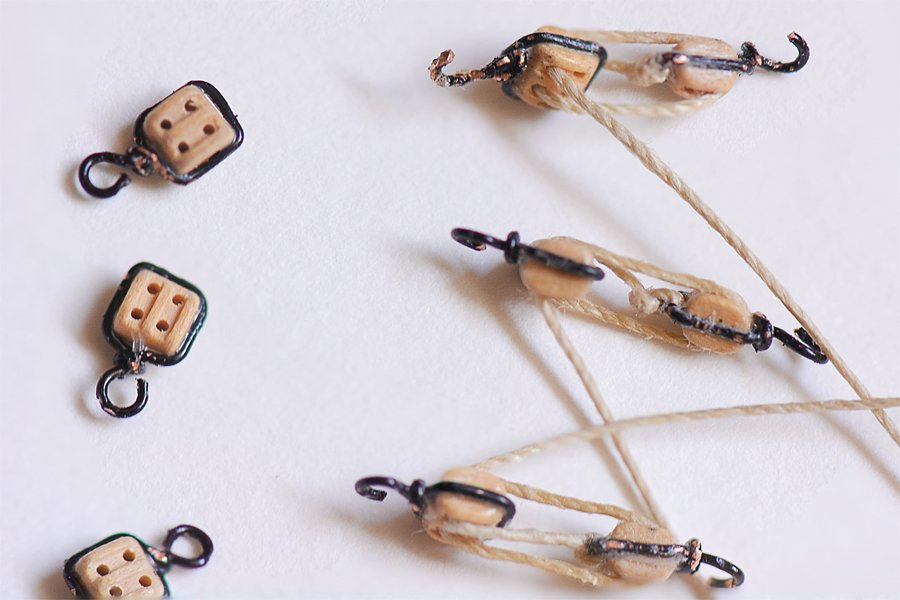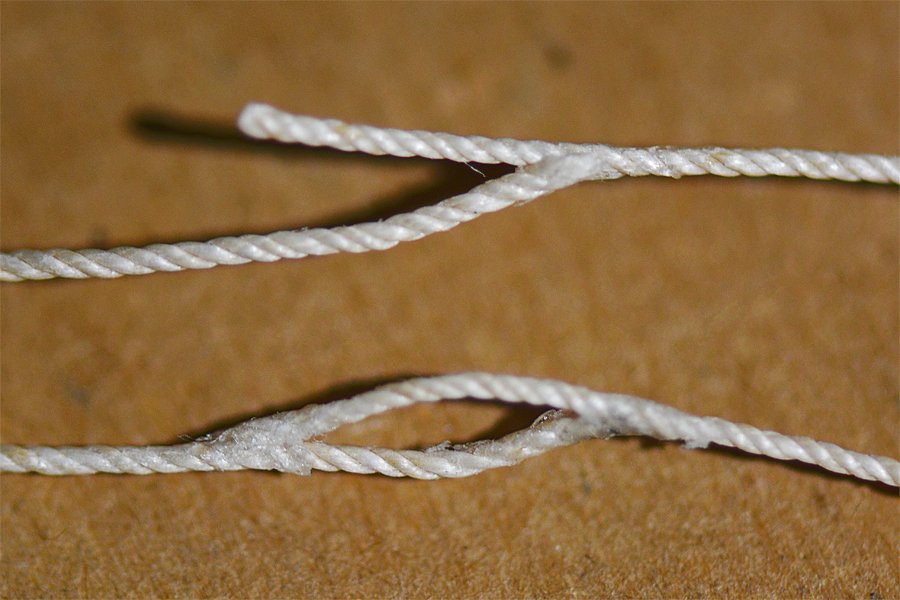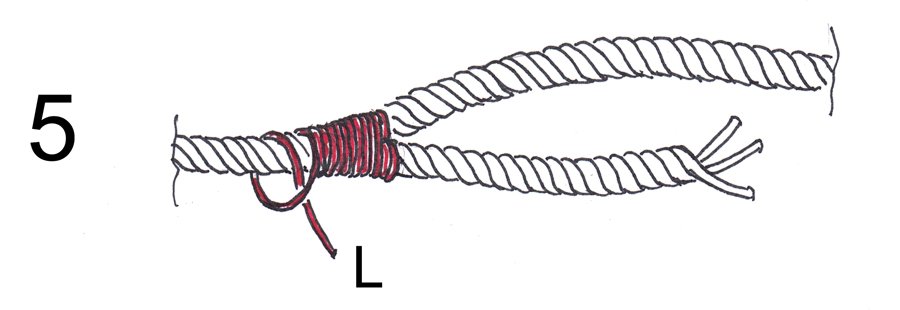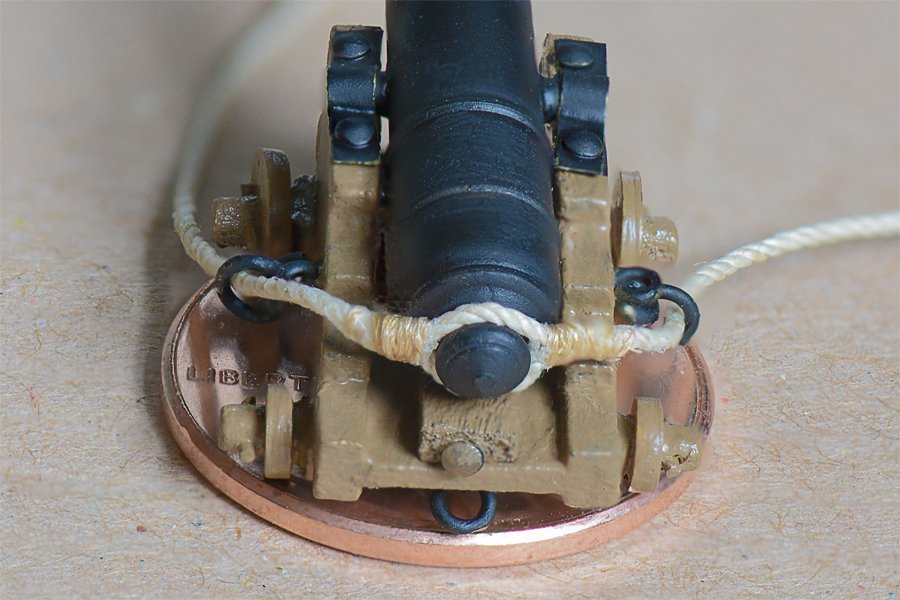-
Posts
2,406 -
Joined
-
Last visited
Content Type
Profiles
Forums
Gallery
Events
Everything posted by Dr PR
-
We are all ignorant of almost everything there is to know - we were born that way. To me "stupid" is the inability to learn, and "dumb" is the refusal to learn. Your are learning so you are neither. I have been building ship models for decades, and I was in the Navy. Even so, I still have problems with a lot of the older terminology - but I am learning!
-
You said you had "Chapelle's book." He has four that discuss revenue cutters and Baltimore clippers, but only the "History of American Sailing Ships" has many plans for revenue cutters. The Bluejacket kit seems to be for the 31 ton design by William Doughty. The "History of the American Sailing Navy" (1985) has drawings of this ship on pages 184, 191 and 196. The drawing on page 191 has the sail plan and spar dimensions. This is the largest drawing of this type I have seen. I suspect the Bluejacket plans are larger than this. Take these sail plans with a grain of salt. There were significant variations from ship to ship, and no one is really sure if any ships were built to Doughty's 31 ton design. Chapelle's "The Baltimore Clipper" is a wealth of information about the general design of the schooners and revenue cutters, but it is a small book with small drawings (and lots of them). It has detailed descriptions of the spars for many of these ships. Note: the original editions of some of Chapelle's books have larger drawings, including many fold out double page size plans. The more recent reprints reduce these plans to a single page. You can find the older editions on Amazon.
- 104 replies
-
- revenue cutter
- BlueJacket Shipcrafters
-
(and 1 more)
Tagged with:
-
Johann, Excellent work! I just discovered this thread this morning, and I have sat here for about 10 hours reading it from start to finish! I have learned a great deal from your work - it is like watching the construction of the real ship. I really appreciate the research you have put into your work! One thing I have been puzzling over is what to do with the loose ends of the gun tackle. I have seen other methods but they didn't seem practical for me, except perhaps when the ship was open for visiting in port and to put on a show. Your method of looping the rope and securing it with small stuff makes sense. This keeps it out of the way but readily available. Another similar method was to loop it over a belaying pin or cleat on the bulwark. I will continue reading your build log with great interest.
-
I would like to add a word of caution about the printable scale idea. Some printers do not print to scale. I had an expensive HP office laser printer that would print a 10.0 inch line from a CAD program as something like 9.94 inches with a 1.0 printing scale in the HP driver. To get it to print the correct length I had to adjust the printing scale to 1.064, and that still wasn't exactly the correct length. It may not sound like much, but 0.06 inch (1.52 mm) is a significant error, and multiple errors can add up to a significant problem. Before you print anything on any printer/plotter where you need a precise dimensions, be sure to test the printer/plotter to see if it actually prints to scale!
-
Thanks.
-
I have a questioning about blackening brass. In many cases I have soldered (tin/lead) brass pieces together and have a bit of visible solder flow at the joints. I use a rotary tool wire brush to remove as much of the solder as possible, and also clean/shine the brass. But the solder (the tin part I think) dissolves into the brass - this is why it makes a strong bond. No amount of polishing short of grinding away the brass will remove the solder "stain." Do any of the blackening agents also blacken the solder, or do they just blacken the brass and leave the shiny solder stain? Phil
-
VTH, This is where a build can get interesting. The actual plank length depended upon the supply of timber when the ship was built. If the trees were tall the planks could be very long. About the only thing you can say for sure about deck plank lengths is that it will be multiples of the spacing of the deck beams. But what is the deck beam spacing? Is it shown on the kit plans? If not you have some research to do. Deck beam spacing is typically the same as or a multiple of the hull frame spacing (not the model bulkhead spacing). How long is the model supposed to be in scale feet (the kit description says 30 to 36 feet)? You can look for other models or drawings of schooners of about the same length and see what was used on them. The scale is 3/8 inch per foot, or 1:32. Overall length of the model is 17 inches, or 45.3 scale feet. So look for plans or drawings for a schooner with a hull of about 36 feet and overall length of about 45 feet.
- 90 replies
-
- finished
- Midwest Products
-
(and 1 more)
Tagged with:
-
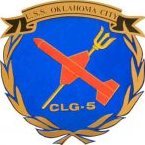
Carriage Gun Rigging
Dr PR replied to Dr PR's topic in Discussion for a Ship's Deck Furniture, Guns, boats and other Fittings
Kieth, I also notice the wheel chocks. Some were used when the cannon was secured for stowage, and others were used during loading to prevent the gun from moving. In the drawing of the stowed gun it appears to me that the training tackle was hooked to a rope that was looped around the cascobel and the other end was hooked to a ring bolt on the bulwark above the gun. Then the tackle was pulled tight to push the gun against the bulwark. The gun tackles and breeching ropes were siezed to take up slack and hold the gun in place. But I have seen other drawings showing different methods of securing the gun. My guess is that it might have been done differently on each ship, depending upon the type of gun, configuration of the gun port and bulwark (if any) and other features peculiar to the ship and crew. When I was in the Navy the ships changed all the time, especially the small details. If the Ship's Bosun decided he needed another cleat or eye he called the engineers and they brought up a torch and added the new piece. In the yards a five pound tin of coffee could buy quite a few unauthorized things! On the old wooden ships you only needed to ask the carpenter. And the Captains had a habit of customizing the configuration of major things like masts and spars to suit their whims. If it isn't too absurd, just about anything you can model has a chance of being "prototypical." -

Carriage Gun Rigging
Dr PR replied to Dr PR's topic in Discussion for a Ship's Deck Furniture, Guns, boats and other Fittings
Thanks to everyone for the comments. I also thought closing the gun ports between shots seemed a bit strange, although the desire to be protected from musket fire and grape shot while the gun was being loaded was obvious. There is even a caution that the men should avoid exposing themselves through the gun port. With a clearance behind the bulwarks to the gun muzzle of only about a foot there wouldn't be room for a typical worm, swab and rammer. As I understood it the men would poke the handles out the gun port to get these long pieces into the barrel. However, I have seen several references, and even videos of modern reenactments, where the sponge/swab was a flexible bunch of rags and ropes that could be bent around and into the barrel. Also, some gun port covers had holes called "ventilation scuttles" (Mondfeld's Historic Ship Models page 177) and I had wondered if the handles were pushed out through these? Maybe these holes are the "port scuttle" mentioned in the Ordnance Instructions? Mark is correct about checking the period and type of ship and guns. There was a lot of variation between ship types and periods, so whatever we model must fit these requirements. But until someone invents a time machine we won't know how things were really done way back when! -
I have been wondering the same thing. Beef wellington (Jason) said this is what he uses: "The fine thread is UNI-Thread W 6/0 Tan - not sure what that means, but that's what's on the reel! Nothing fancy, think I picked it up at a local craft store some time ago, its synthetic so need to use GS-Hypo cement rather than PVA if it needs to be secured." I would think the caution about the glue would also apply to fishing line. The GS-Hypo cement is something jewelers have used since the 1930s. It is supposed to not harden and remain flexible. I haven't used it myself but I will look for it at the local crafts store.
-
This is a rehash of much I have found on the forum and possibly some new information. I have seen discussion of how to model the rigging of carriage guns, with lots of speculation. I hope to condense this a bit here. Here are some drawings of British and American gun tackle and breeching lines. The breeching lines are attached to ring bolts on the bulwarks and are attached to the cascobels at the rear of the cannon. In some cases they are wrapped around the cascobel as shown at the left. Sometimes they were attached with a cut splice that fit around the cascobel, as shown at the right. Later guns had a breeching ring cast into the barrel above the cascobel, and the breecing line passed through it. The breeching line stopped the recoil of the gun when it was fired, preventing it from crashing about the deck. It was roughly 1/3 the diameter of the shot, and was long enough (3 times the length of the cannon bore) to allow the cannon to move about a foot or two inboard of the bulwark to give the gun crew room to swab and load the cannon. There were very specific methods of attaching the breeching lines to the bulwark ring bolts, normally using seizing of small line wrapped around the breeching line. The gun tackle (outhaul tackle) hooked to a ring bolt on the bulwark, and hooked to a ring bolt on the gun carriage. The gun tackle was used to haul the gun out to the battery (firing) position after it was loaded. This tackle for larger guns consisted of a single block hooked to the gun carriage and a double block hooked to the bulwark. Smaller guns might just use two single blocks. A "loose end" (pun intended) in the descriptions of the gun tackle is what to do with the falls (loose ends) of the tackle? The line leading from the block attached to the bulwark had to be long enough for the gun crew to grab. Then when the gun was hauled to battery and the blocks came together, more line, 3-4 times the longest distance between the blocks when the gun was in the loading position, was pulled out of the tackle - that is a lot of line. Typically drawings just show the falls going off somewhere. What did they do with all of that line? I have seen four variations for dealing with the gun tackle falls. The picture on the left above shows the loose ends "frapped" (wrapped) around the tackle. However, most of the falls was taken up by looping it a few times through the rings on the hooks at the bulwark and gun carriage, with the remaining part frapped around the bundle of lines. This would have been used to secure the guns when they weren't being used, in port or at sea. Note the breeching loop cast into the rear of the cannon. The picture right above shows the end of the falls "Flemished" in a tight spiral on the deck. Many models use this method because it is a simple way to deal with the loose ends. However, on real ships this was done for show only, during inspections or ship visiting days. There is no way this would have been used at sea! The loose ropes would be scattered all over the deck, and this was not good! Another way to secure the gun tackle loose ends that I have seen was to belay the line around cleats or belaying pins on the bulwarks. This would be a "ready stowage" solution to keep the ropes from flopping around the decks and getting tangled while approaching a battle. But it could also be used when the guns were secured. Another method was to just roll the line into a lose coil and place it on the deck near the bulwark block. Again, this would have been a temporary stowage while preparing for battle. In battle the falls would have been pulled taut straight back from the block along side the cannon by the side tacklemen, and perhaps faked down on deck for long falls. When the gun was fired the line ran cleanly through the block - the tackle absorbed some of the recoil momentum. Note: Not everyone is happy with this explanation - see the references below to support my reasoning. **** The training tackle (inhaul tackle) was similar to the gun tackle. It hooked to a ring bolt at the rear of the gun carriage and to another ring bolt mounted in the deck some distance behind the gun. The training tackle was used to haul the gun back inboard to the loading position. Some ships used a single training tackle, others used two training tackles (only the heaviest guns >= 36 pounders had two training tackles), and you often see pictures and drawings where no training tackle is used. What did they do with the training tackle when it wasn't being used? Apparently it was stowed with all the other gun handling gear, often on the bulwarks between the guns, at least while they were preparing for battle. When the guns were secured all the loose paraphernalia was probably stowed below. This drawing shows a Continental (French, Dutch, etc.) style gun. First note that the breeching line passes through a hole in the gun carriage, and it does not attach to the cannon. It serves the same function, to stop the recoil, and it must be long enough to allow the gun to move inboard at least 1/3 meter for loading. The drawing shows the gun in a stowed position with the end of the barrel raised (with the quoin removed) and pulled tightly against the top of the inside of the gun port. This was common in all navies, but there were probably as many variations as there were ships. The tackle was used to draw the gun tight against the bulwark, and lines were frapped to take up slack. Chocks were also used to secure the gun. The last thing you wanted was a loose cannon rolling around the decks in heavy seas! The answers to many of these questions are found in Ordnance Instructions for the Unites States Navy (1860) which can be downloaded here: https://archive.org/details/ordnanceinstruc00ordngoog Gun and train tackles were not removed before the gun was fired (pages 45 -47)! Up to the Ready/Fire commands the side tacklemen held the falls taut. At the command "fire!" side tacklemen dropped the tackle and falls and let them run to slow the recoil. The train tacklemen pulled on the falls to take up the slack as the gun recoiled, and then held the gun until it was loaded. However, the train tackle could be unhooked before firing in calm seas and then attached after recoil. Note: The text describes when the gun tackles are hooked to the bulkheads and to the rings on the gun carriage, and which of the gun crew does each task. It never mentions unhooking the gun tackle until the gun is to be secured and stowed. In the drawing below the gun tackles and training tackles are attached in the firing position. The gun was pointed by hauling it in to the extent allowed by the breeching line, and then one or the other side tackle was hauled in to swing the gun left or right (page 46). Here is a diagram showing pointing, firing and loading: Breeching must be long enough to allow the gun to clear the gun port at least one foot when hauled fully inboard. Neither breeching nor tackle can be blackened or treated in any other way that reduces flexibility. They are to be made of manila or another pliable rope. (page 150). I haven't read it all, but I couldn't find any description of how the gun tackle falls were to be secured/stowed when not in use. However, at the command "cast loose" the tackles were to be removed from stowage and then hooked to the bulwark and gun carriage. So maybe they were not hooked to the guns while they were stowed? Or were the frapped tackle considered "stowed?" **** As far as placement of the ring bolts for the gun tackle on the bulwarks, the diagram above shows the attachment points spaced far from the gun port to allow a significant angle of pull on the tackle for pointing the gun. But most photos and drawings do not show them as widely spaced as in the drawing above. I have also see (somewhere) a drawing showing double ring bolts for the train tackle on the bulwarks, on each side of the gun port, spaced fairly close together, in case one bolt fails. In the description of how to point the gun it says the gunners used the handspikes to lever the gun left/right to assist the tackle. So it wasn't necessary for the gun tackles to be spaced widely as shown in the diagram above. The tackle could be used to hold and fine tune the point. The handspikes were also used to raise the breech to free the quoin so it could be repositiond to change the gun elevation. One other detail I had been wondering about - the port tackle (for the gun port lid) was secured to a cleat on the inner top of the gun port. The door/lid was to be raised high to prevent damage from the blast of the gun. After each shot the port lids might be closed to provide protection for the gun crews while they were reloading. **** There is a lot of useful information in this document. It was written in 1855 and amended in 1860, but gunnery practices probably had not changed much in centuries except as new gun types were introduced. The referenced text describes practices for smooth bore muzzle loading guns. **** I hope this is helpful, and that it will stimulate further discussion.
-
The answers to many of our questions are found in Ordnance Instructions for the Unites States Navy (1860) which can be downloaded here: https://archive.org/details/ordnanceinstruc00ordngoog First of all, gun and train tackles were not removed before the gun was fired (pages 45 -47)! Up to the Ready/Fire commands the side tacklemen held the falls taut. At the command "fire!" side tacklemen dropped the tackle and falls and let them run to slow the recoil. The train tacklemen pulled on the falls to take up the slack as the gun recoiled, and then held the gun until it was loaded. However, the train tackle could be unhooked before firing in calm seas and then attached after recoil. Note: The text describes when the gun tackles are hooked to the bulkheads and to the rings on the gun carriage, and which of the gun crew does each task. It never mentions unhooking the gun tackle until the gun is to be secured and stowed. The gun was pointed by hauling it in to the extent allowed by the breeching line, and then one or the other side tackle was hauled in to swing the gun left or right (page 46). Here is a diagram showing pointing, firing and loading: Breeching must be long enough to allow the gun to clear the gun port at least one foot when hauled fully inboard. Neither breeching nor tackle can be blackened or treated in any other way that reduces flexibility. They are to be made of manila or another pliable rope. (page 150). I haven't read it all, but I couldn't find any description of how the gun tackle falls were to be secured/stowed when not in use. However, at the command "cast loose" the tackles were to be removed from stowage and then hooked to the bulwark and gun carriage. So apparently they were not hooked to the guns while they were stowed. **** As far as placement of the ring bolts for the gun tackle on the bulwarks, the diagram above shows the attachment points spaced far from the gun port to allow a significant angle of pull on the tackle for pointing the gun. But most photos and drawings do not show them as widely spaced as in the drawing above. I have also see (somewhere) a drawing showing double ring bolts for the train tackle on the bulwarks, on each side of the gun port, spaced fairly close together, in case one bolt fails. In the description of how to point the gun it says the gunners used the handspikes to lever the gun left/right to assist the tackle. So it wasn't necessary for the gun tackles to be spaced widely as shown in the diagram above. The tackle could be used to hold and fine tune the point. The handspikes were also used to raise the breech to free the quoin so it could be repositiond to change the gun elevation. One other detail I had been wondering about - the port tackle (for the gun port lid) was secured to a cleat on the inner top of the gun port. The door/lid was to be raised high to prevent damage from the blast of the gun. After each shot the port lids were closed to provide protection for the gun crews while they were reloading. **** There is a lot of useful information in this document. It was written in 1855 and amended in 1860, but gunnery practices probably had not changed much in centuries except as new gun types were introduced. The referenced text describes practices for smooth bore muzzle loading guns.
-
Jason, Thanks for the information. Your 1:64 build is very clean and neat! Much more so than my 1:48, so I was wondering how you do it. But I think I understand now. The Diana/Jason was 121 feet on the keel and 146 feet overall. My Baltimore clipper was 68 feet between perps. Your model will be about 22 inches on the keel while mine is about 17 inches, so yours is about 1/3 larger. I would expect the larger scale model to be neater than a smaller scale just because wood grain, loose thread fibers, dust etc. would be smaller relative to the model. However, your model appears to have less of those details and fewer visible imperfections in the photos - especially the guns. I am envious! However, I am modeling 6 pounder cannons at 1:48 and you are modelling much larger 18 pounder guns at 1:64, so your model cannon and carriages are about 1.75 times as large as mine! In the close up photos my imperfections and dust get 3-4 times as many pixels - and I am using one of the best macro lenses made (Nikon 105 mm macro) that makes very sharp pictures of the imperfections! Now I think my work isn't quite as crude as I thought compared to yours. Because of some peculiarities of the kit I am building (and my kitbash) I had to make the gun carriages from scratch. I think they look OK, but for future builds I will try to use Chuck's gun carriages. They are very clean. I am using the Syren 3/32 blocks for the gun tackle, and they are very small! As you said, these blighters take time!
-
Bob, Good photos. They show the frapping well. I agree that it would make sense to unhook the tackle, at least from the gun carriage, before firing the gun. There is too much chance that the fall will be tangled and jam in the block. With a single/double block tackle there are four lines running between the blocks. So for every foot of gun recoil four feet of the fall would be drawn into the blocks. The rope would be whizzing through the tackle very fast. I don't think that could be managed to avoid tangles very easily, but experienced gunners might have had a way to do it. However, I have seen other discussions on this forum saying that the tackle was attached and acted as a shock absorber as the lines ran through it. I have also read that the hooks were moused. But that is all speculation. I would also guess that the gun tackle was also used as training tackle, since both would not normally be in use at the same time. Just unhook it from one position and move it to the other. In this case the hooks certainly would not be moused! The drawings I have seen show both the breeching line and the gun tackles fastened to ring bolts that penetrated through the timbers and planking to fasteners on the outside of the hull. If these could take the shock of the breeching line they would also be able to withstand the lesser shock of a gun tackle slowing the recoil. Somewhere here I read a post that quoted from a 19th century gunnery manual, but I don't remember who had it. That might answer the questions. I have looked through several books that I have for rigging sailing ships but they don't mention the guns. Note in your first picture that there are belaying pin rails to either side of the gun where the falls could be belayed when the gun was not in use. But they would not necessarily be used. Again, speculation. Also notice that the fall was looped through the eyes of the hooks at least twice before the frapping was wound. This took up most of the falls and only the free end was used for frapping. So the part of the line that passes through the blocks would not be wound in the frapping. Have we hijacked Jason's thread? Should this discussion be elsewhere?
-
I have been wondering what to do with the falls from the gun tackle. I have seen four methods - so far. 1. Flemish coils on the deck. I have seen the ends of ropes Flemished on some of the ships I have served on, but only for show when we were having an inspection or open ship (visiting ship). There is no way this method would have been used at sea! The unsecured ropes would soon be scattered all over the deck. 2. Frapping similar to what Jason has done. However, the fall (the part pulled upon) is usually fairly long and is often looped around the hooks at either end of the tackle before the remaining line is frapped around the rest between the blocks. This would be done when the guns were stowed in port and possibly when at sea with no probability of using the guns. 3. I have seen drawings showing guns run out and ready for action with the falls loosely coiled (not Flemished) on the deck near the double block by the bulwark. This would position the rope out of the way of the crew and ready to run through the blocks as the gun recoiled. The coil would have to be arranged carefully to avoid tangled loops that would hang up on the blocks. Maybe the line would be uncoiled and pulled taut just before the gun was fired to ensure it would run free without tangles. 4. A fourth method that would be used when the guns were run out, but not to be fired immediately, was to loop the rope over a cleat or belaying pin on the bulwark near the double block. This would keep the line off the deck and in a known untangled state that could be prepared for firing quickly. I suspect this method would be used when there was a potential for action but the ship was not at quarters (Condition 1 or General Quarters) - what we called "Condition 2" when I was in the Navy. I have seen only one drawing showing this, and I don't recall seeing it on a model. I am considering either method 2 or 4 for my current model. Remember that sailing ships moved very slowly - even the fastest clippers went only about 16 knots average. Sails on tall ships would be visible at a distance of 20 miles or better (up to 40 miles from the tops) and it would take quite a while for the ships to come into gun range after they spotted the enemy. Even if both ships sailed toward each other, at 6-8 knots it would take hours to close within smooth bore gun range. That would be plenty of time to prepare and run out the guns.
-
Jason, I just came across your build. Very impressive!! What size Syren blocks did you use for the gun tackle? Your work is very neat. I have been trying to decide what to do with the falls (loose ends) of the gun tackle. Your example of frapping is interesting. The Syren gun carriages are very neat. You may have stated this earlier, and I missed it, but what finish did you use for the red color? One last question (for now). What did you use for the very thin thread seizing around the splices in post #614??
-
Nils, I plan to rig the ship - someday. Considering that this model has been in progress for about 35 years now it may be a while before it is finished! I don't know about sails. That depends upon how ambitious I am, and how much of a hurry I am to move on to other things. I resumed this build mainly as a learning experience, to hone my talents at ship building and learn something about the Baltimore clippers.
-
Sam, Thanks. I think everything posted on the forum is there for us to use and learn. I am still trying to figure out what to do with the loose ends of the tackle falls. Placing them in Flemish coils is a popular - and cute - method. But no working ship would have those. Loose ropes scattered across the decks is the last thing you would want!
-
I am working on the cannon gun tackle. I am using Syren Ship Model 3/32" single and double blocks - the smallest that Chuck makes. Even these tiny blocks may be a bit oversized, but they look pretty nice. They are about 4-5/8 scale inch long. The line is 0.013 inch diameter thread which is about 5/8" scale. The 1-1/2 scale inch breech line is about right for a 6 pounder cannon. The "iron" straps around the blocks and hooks are made of 0.015 inch blackened brass wire, and the ring bolts are 0.019 inch brass with the loops soldered closed. I had two problems trying to create the gun tackle. At first I was going to have rings on the blocks - one on the double block and one on each end of the single block. Separate hooks would attach to the ring bolts on the bulwark and gun carriage. The line would attach to one of the rings on the single block. But the space between the ring bolts was less than 0.5 inch when the gun was run out, and all of the rings and hooks came out to be about 0.65 inches-that wouldn't do! The solution was to have only one ring on each block, and to open it into a hook to attach to the ring bolts on the bulwark and gun carriage. The line attached to the single block with a knot around the wire strop. That made the tackle short enough to fit the space. The other problem was the tendency of the thread to bulge out in an unnatural loop between the blocks. The solution was to paint the thread with white glue and stretch the tackle until the glue dried. I cobbled together this tool from scrap wood and brass nails. The tool held the strands taut while the glue dried, producing a tackle with the correct length that appeared to have some strain on it. The Syren 3/32 inch blocks are very nice - and very small! Wrapping the wire around them to form the strops was tedious. I created a metal tool with the cross section of the blocks to wrap the wire around and form the loop/hook. The wire fit tightly around the blocks and was held in place with white glue just to be sure. At first it took me about an hour for each block, with several failed attempts. But after the first few I figured it out and it probably took only 10-15 minutes each. I'd guess it took about the same amount of time to rig the tackle, and I let the glue dry for at least half an hour on each. I have been working about three weeks off and on with the 12 sets of gun tackle and breech lines. I am glad I have only six cannons to rig!
-
Slow build? What's the rush? I built my first wooden ship model kit in about six months - that was in the early '70s (Billings Boats Santa Maria). I started another kit but had to put it aside. The build resumed in the 1980s and was completed in about 15 years after I started (brig Freya - I don't know what the company was but it was from West Germany). A third kit was started in the mid 1980s, but it was shelved after the hull was planked (Mantua Albatros Baltimore clipper). Another project came along and that took 14 years (CAD model of USS Oklahoma City CLG-5)! Now I have resumed the 1980s Albatros kit, about 35 years after I started it. I'm not sure if I will complete it, or shelve it again to work on a scratch build I have been planning (1:96 USS Oklahoma City CLG-5). And I have a Mamoli Rattlesnake kit on the shelf, waiting it's turn. But with all of them I have learned a lot! And I have enjoyed them all. For me that's what it is all about.
-
Sam, Laser cutting is probably the best way to create one-off pieces like you describe. We have used clear two-part potting materials for water tight casings for oceanographic equipment. When it sets up it forms a water clear plastic like material. You can enclose just about anything this way, but you need to degass the stuff in a vacuum chamber to eliminate bubbles. Or you might be able to sandwich the metal sheet between two sheets of plastic. Phil
-
Are you looking for a photo-etched metal sheet or a "printed" circuit board (glass fiber resin core with multiple layers of etched traces)? What quantity are you looking for? Metal photo etch and circuit boards are not the same thing. There are numerous printed circuit board manufacturers on line. Some will do small lots with a day or two turnaround. Likewise, there are photo-etch shops on line.
-
I have been working on the breaching lines for the cannons. I wanted to use a cut splice around the cascobel at the rear of the cannons, but I found that I could not glue together pieces of the rope supplied with the Mantua kit. This is a photo of what I was trying to do. But none of the glues (wood glue, cyanoacrylate, white glue, etc.) would stick to the rope. Even acetone based model cement didn't penetrate the fibers! However, it did eventually create a coating around the threads that held the pieces together. But this wasn't a satisfactory solution! There was no way I was going to try to implement an actual splice by pushing fuzzy ends of threads between the windings of the 0.026 inch diameter rope. I found a drawing in Biddlecombe's "The Art of Rigging" showing serving over the splices in a cont splice. I decided to try this. 1. I unraveled a short section (1/16 inch or 1.5 mm) of the ends of two pieces of the rope. 2. Using a thin thread (red) I placed a simple overhand knot near the short end (S) without pulling it tight. Then I looped the long end (L) of the thread back through the first knot and created a second overhand knot loop without tightening it. 3. The two thread loops were pulled over the two pieces of rope without tightening the loops as shown in drawing 3.. 4. The two thread loops were pulled to within about 1/16 inch of the end of the unraveled end of one piece of rope. Then I pulled both knots tight. This attached the thread to both pieces of the rope and pulled them together tightly. The short end (S) of the thread was pulled along the standing part of the rope along with the unraveled strands of the other piece as shown in drawing 4. The serving will wrap around the short end and prevent the knot from becoming untied. I placed a small drop of glue on the thread knots and rope where the raveled ends of the first piece of rope were, and pulled these ends around the standing part of the second piece of rope. I used Duco Cement, but just about any glue will do if it soaks into the thread. You want a cement that takes a few minutes to set up. 5. Working quickly I wrapped the long end of the thread around the two pieces of rope, working along the unraveled ends. I pulled the thread tight around the unraveled ends and down into the glue. Occasionally I used tweezers to push the thread loops together into a tight winding. When I had wound the thread past the unraveled ends of the rope I tied it off with a half hitch knot around the standing part of the rope. 6. Then I applied cement over the turns of the thread and worked it into the thread with my fingers (super glue wouldn't be a good choice). 7. After the glue set the loose ends of the thread were cut off and a bit more glue applied to hold the fibers in place. That finished the first half of the splice. 8. I pulled the rope "Y" tight around a drill bit that was slightly smaller than the diameter of the neck of the cannon's cascobel. 9. The open ends of the rope "Y" were pulled together tightly and I repeated steps 2 and 3 to make overhand knots around the two pieces of rope, pulling the knots tight. 10. I pulled the assembly off the drill bit and placed a small drop of glue at the join. 11. I repeated steps 4 and 5 to fasten the two ropes together. Before I had progressed very far - several turns - I clipped the short end of the rope to the proper length and unraveled the ends. 12. Then I finished wrapping the thread past the raveled ends and tied it off as before. 13. Finally, I clipped the loose ends of the thread and rubbed glue into the turns of thread and let it set. I used a "fid" to open the loop in the splice - a muscle separator dissecting tool works very well, but any wood or metal rod that tapers to a point will do. Then the loop was forced over the cascobel. It was a tight fit and the cut splice stays in place on the cannon without having to use glue to hold it. Here is a photo of a 1:48 scale 6 pounder cannon sitting on a US penny for size reference. The breeching line is 1 1/2 scale inches diameter. This scheme has the advantage that the thread is attached to the rope pieces with knots, preventing the rope from pulling out of the serving. The glue holds the serving in place. What you see in the photo was my first attempt, and it came out acceptable.
-
I built a plank-on-frame model about half a century ago using small metal nails that were supplied with the kit. I just looked at it again and the nails are still there and have not rusted. I pushed the nails in so the heads were below the plank surface and then filled in over the nail with something (probably a mixture of wood dust and glue) and sanded it smooth. However, the nail locations are visible if the light angle is right. I used a pin pusher of some sort, and it took a bit of practice. You have to concentrate and use a steady push perpendicular to the plank surface. If you do not push very close to perpendicular the nail will bend over and make a nasty dent in the plank. But I remember it wasn't hard after I learned how. The hull planks were thin and the plywood frames offered little resistance. You do run the risk of missing the frames or splitting them - the nail won't hold in either case. I am pretty sure I did not drill the holes for the nail before pushing them in. I probably pushed the nail in as far as I could - with the heads "proud" above the planks - and then hammered them with a punch to get them below the plank surface. **** I agree with the others that just gluing and clamping the planks is better than messing with the nails.
About us
Modelshipworld - Advancing Ship Modeling through Research
SSL Secured
Your security is important for us so this Website is SSL-Secured
NRG Mailing Address
Nautical Research Guild
237 South Lincoln Street
Westmont IL, 60559-1917
Model Ship World ® and the MSW logo are Registered Trademarks, and belong to the Nautical Research Guild (United States Patent and Trademark Office: No. 6,929,264 & No. 6,929,274, registered Dec. 20, 2022)
Helpful Links
About the NRG
If you enjoy building ship models that are historically accurate as well as beautiful, then The Nautical Research Guild (NRG) is just right for you.
The Guild is a non-profit educational organization whose mission is to “Advance Ship Modeling Through Research”. We provide support to our members in their efforts to raise the quality of their model ships.
The Nautical Research Guild has published our world-renowned quarterly magazine, The Nautical Research Journal, since 1955. The pages of the Journal are full of articles by accomplished ship modelers who show you how they create those exquisite details on their models, and by maritime historians who show you the correct details to build. The Journal is available in both print and digital editions. Go to the NRG web site (www.thenrg.org) to download a complimentary digital copy of the Journal. The NRG also publishes plan sets, books and compilations of back issues of the Journal and the former Ships in Scale and Model Ship Builder magazines.



